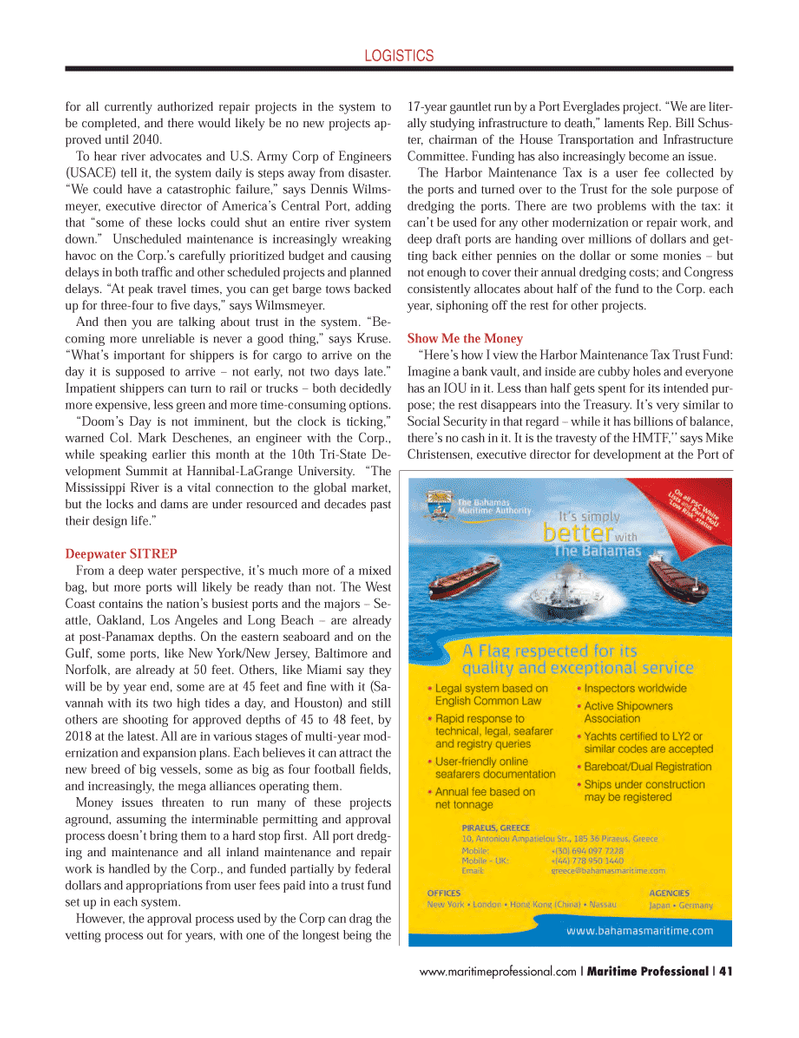
Page 41: of Maritime Logistics Professional Magazine (Q2 2014)
Maritime Risk & Shipping Finance
Read this page in Pdf, Flash or Html5 edition of Q2 2014 Maritime Logistics Professional Magazine
www.maritimeprofessional.com | Maritime Professional | 41 for all currently authorized repair projects in the system to be completed, and there would likely be no new projects ap- proved until 2040.
To hear river advocates and U.S. Army Corp of Engineers (USACE) tell it, the system daily is steps away from disaster. “We could have a catastrophic failure,” says Dennis Wilms- meyer, executive director of America’s Central Port, adding that “some of these locks could shut an entire river system down.” Unscheduled maintenance is increasingly wreaking havoc on the Corp.’s carefully prioritized budget and causing delays in both traffi c and other scheduled projects and planned delays. “At peak travel times, you can get barge tows backed up for three-four to fi ve days,” says Wilmsmeyer.
And then you are talking about trust in the system. “Be- coming more unreliable is never a good thing,” says Kruse. “What’s important for shippers is for cargo to arrive on the day it is supposed to arrive – not early, not two days late.”
Impatient shippers can turn to rail or trucks – both decidedly more expensive, less green and more time-consuming options. “Doom’s Day is not imminent, but the clock is ticking,” warned Col. Mark Deschenes, an engineer with the Corp., while speaking earlier this month at the 10th Tri-State De- velopment Summit at Hannibal-LaGrange University. “The
Mississippi River is a vital connection to the global market, but the locks and dams are under resourced and decades past their design life.”
Deepwater SITREP
From a deep water perspective, it’s much more of a mixed bag, but more ports will likely be ready than not. The West
Coast contains the nation’s busiest ports and the majors – Se- attle, Oakland, Los Angeles and Long Beach – are already at post-Panamax depths. On the eastern seaboard and on the
Gulf, some ports, like New York/New Jersey, Baltimore and
Norfolk, are already at 50 feet. Others, like Miami say they will be by year end, some are at 45 feet and fi ne with it (Sa- vannah with its two high tides a day, and Houston) and still others are shooting for approved depths of 45 to 48 feet, by 2018 at the latest. All are in various stages of multi-year mod- ernization and expansion plans. Each believes it can attract the new breed of big vessels, some as big as four football fi elds, and increasingly, the mega alliances operating them.
Money issues threaten to run many of these projects aground, assuming the interminable permitting and approval process doesn’t bring them to a hard stop fi rst. All port dredg- ing and maintenance and all inland maintenance and repair work is handled by the Corp., and funded partially by federal dollars and appropriations from user fees paid into a trust fund set up in each system.
However, the approval process used by the Corp can drag the vetting process out for years, with one of the longest being the 17-year gauntlet run by a Port Everglades project. “We are liter- ally studying infrastructure to death,” laments Rep. Bill Schus- ter, chairman of the House Transportation and Infrastructure
Committee. Funding has also increasingly become an issue.
The Harbor Maintenance Tax is a user fee collected by the ports and turned over to the Trust for the sole purpose of dredging the ports. There are two problems with the tax: it can’t be used for any other modernization or repair work, and deep draft ports are handing over millions of dollars and get- ting back either pennies on the dollar or some monies – but not enough to cover their annual dredging costs; and Congress consistently allocates about half of the fund to the Corp. each year, siphoning off the rest for other projects.
Show Me the Money “Here’s how I view the Harbor Maintenance Tax Trust Fund:
Imagine a bank vault, and inside are cubby holes and everyone has an IOU in it. Less than half gets spent for its intended pur- pose; the rest disappears into the Treasury. It’s very similar to
Social Security in that regard – while it has billions of balance, there’s no cash in it. It is the travesty of the HMTF,’’ says Mike
Christensen, executive director for development at the Port of
LOGISTICS 34-49 Q2 MP2014.indd 41 5/20/2014 9:13:52 AM

 40
40

 42
42
